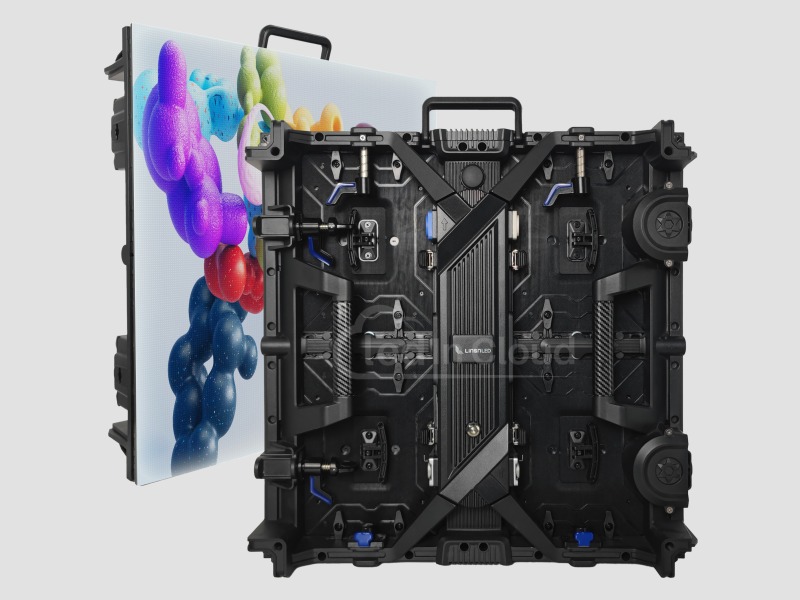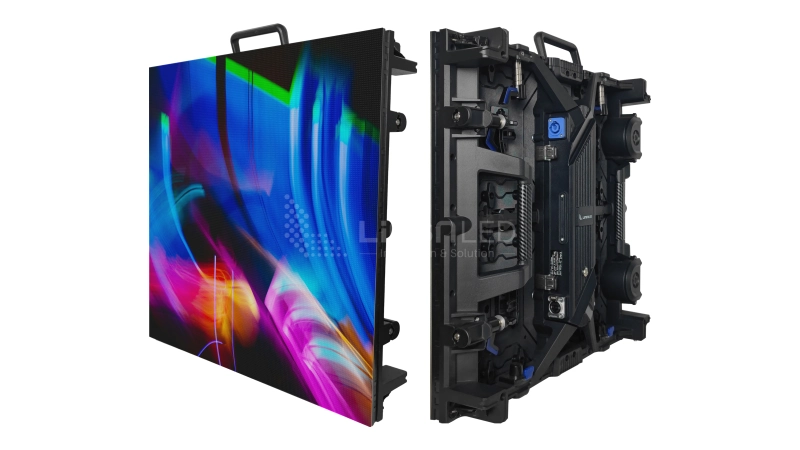
XR LED Screen
Step into the future of film and broadcasting with our advanced XR LED Screens. Designed for virtual production, live streaming, and high-end studio environments, these displays bring digital worlds to life in real time. By combining LED technology with camera tracking and real-time rendering, XR LED walls deliver stunning visuals directly in-camera—eliminating the limits of green screen.
✔ Seamless backgrounds with ultra-high resolution and brightness
✔ Realistic lighting and reflections straight from the LED wall
✔ Stable performance with 7680Hz refresh rate and 16-bit grayscale
✔ Perfect for film studios, commercials, live shows, and virtual events
Top Picks for XR Stage & Virtual Filming
We create XR LED display solutions tailored for the demanding needs of film, television, and virtual production. Engineered with advanced processing and precise design, these screens perform seamlessly under professional cameras.
- 500×500mm cabinet for flexible stage setups
- 16-bit processing ensures smooth grayscale and fine detail
- 7680Hz refresh rate delivers flicker-free performance on camera
- 15,000:1 contrast ratio for deep blacks and sharp highlights
- Wide color gamut covering 96% DCI-P3 and 98% NTSC
- Supports Active Shutter 3D for advanced visual effects
LED Display Price Calculator
Just fill the sizes, and get your LED screen budget right now !
The Technical Threshold of XR LED Display
XR filming demands much higher standards than conventional LED use.
Refresh Rate
Needs 7680Hz or above to prevent flicker, scan lines, or black frames when filmed with professional cameras.
Grayscale
Must achieve true 16-bit depth, or shadows lose detail and gradients break into visible steps on screen.
Color Uniformity
Panels must keep consistent blacks, brightness, and color. Any mismatch creates visible patchy blocks on the wall.
Low Latency
Delay must stay within 1–2 frames. Otherwise, the background won’t sync with the camera’s movement.
LedInCloud XR2.6 vs Conventional Products
Choosing the right LED screen is critical in virtual production. The LedInCloud XR2.6 is designed for XR stages and high-end filming, while conventional LED products are usually built for events or advertising. Here’s how the XR2.6 stands apart:
Ink Color Uniformity
XR2.6: Uses advanced ink coating and customized LED chips to keep the screen surface uniform. Blacks stay pure and deep even under studio lighting. This is critical in XR filming because uneven blacks create visible patches and ruin immersion. With XR2.6, dark scenes like space backdrops or night cityscapes remain clean and consistent.
Conventional: Panels often show different shades of black across cabinets, leading to “checkerboard” effects on camera. Under bright spotlights, black areas can turn gray, making it harder to blend digital and physical elements.
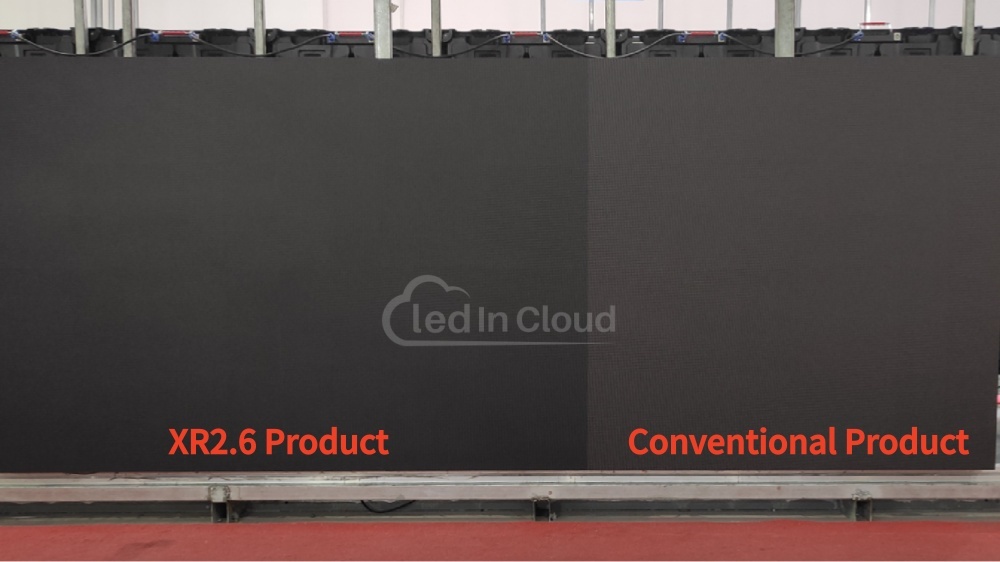
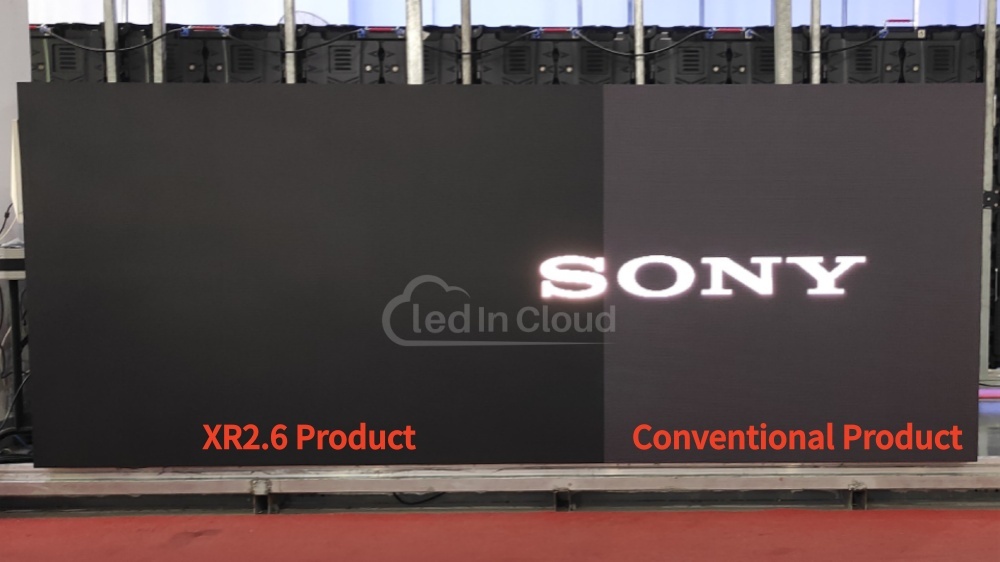
Contrast Ratio
XR2.6: Delivers an ultra-high 15,000:1 contrast ratio. Highlights shine without blowing out, and shadows keep detail. For example, in a scene with car headlights at night, you can see both the glare of the lamps and the subtle texture of the road. This adds cinematic depth and realism.
Conventional: Typically around 7,000:1, which flattens the image. Bright parts look dull, dark areas lose detail, and the whole picture feels less three-dimensional.
Grayscale Performance
XR2.6: Supports true 16-bit grayscale hardware processing. That means smooth gradations from dark to light, with no visible banding. Subtle elements like skin tones, clouds, or shadows in a forest come through naturally, which is vital for close-up shots.
Conventional: Usually limited to 13-bit or simulated 16-bit. Darker areas often look crushed, and gradients break into visible steps, which reduces realism in film-quality content.
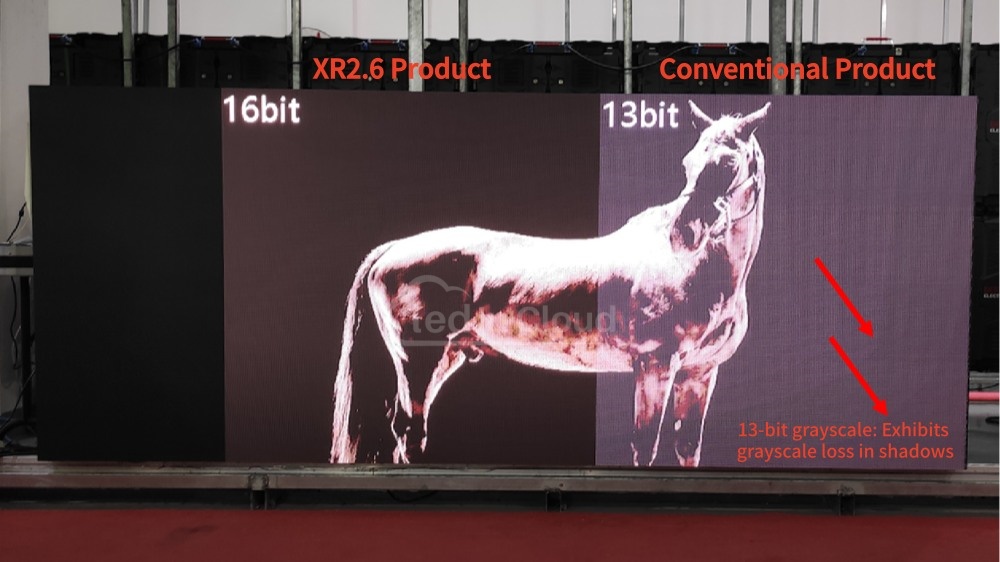
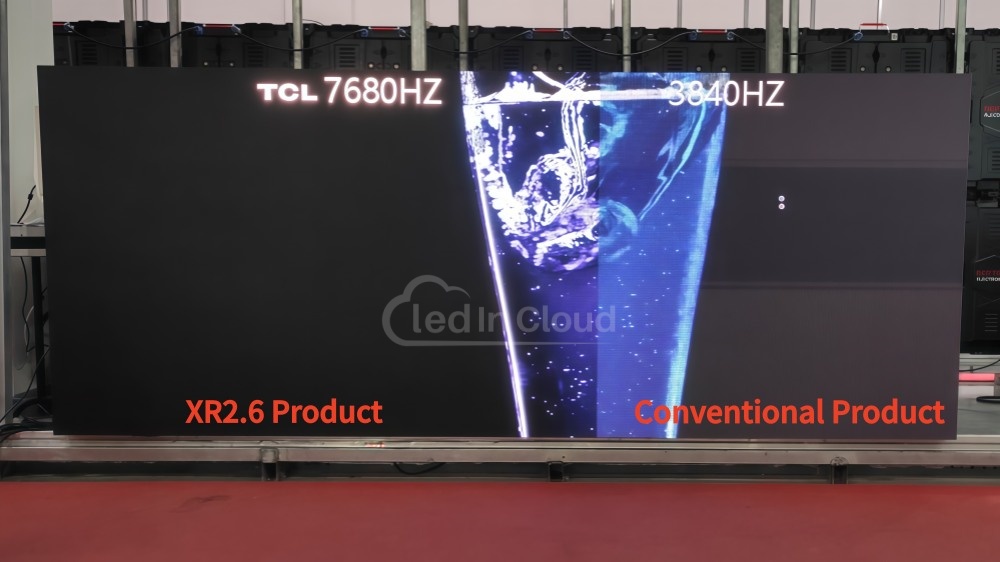
Refresh Rate & Camera Performance
XR2.6: Runs at a 7680Hz refresh rate, with low-gray high-refresh technology. This eliminates flicker, scan lines, and black frame issues, even when shooting at high shutter speeds or slow-motion. Multi-camera setups also stay stable thanks to precise sync.
Conventional: Around 3840Hz, which is fine for live events but not for cameras. When filmed, black scan lines or flicker often appear, forcing crews to fix shots in post or limit camera settings.
Color Gamut
XR2.6: Covers 96% of DCI-P3 and 98% of NTSC, thanks to customized LED chips and optimized driver ICs. This wide gamut means more vibrant reds, rich greens, and deep blues. For productions aimed at cinema or HDR streaming platforms, this ensures color accuracy across devices.
Conventional: Narrower gamut, often just sRGB-level coverage. Colors look washed out, brand logos appear inaccurate, and scenic backdrops fail to match the director’s vision.
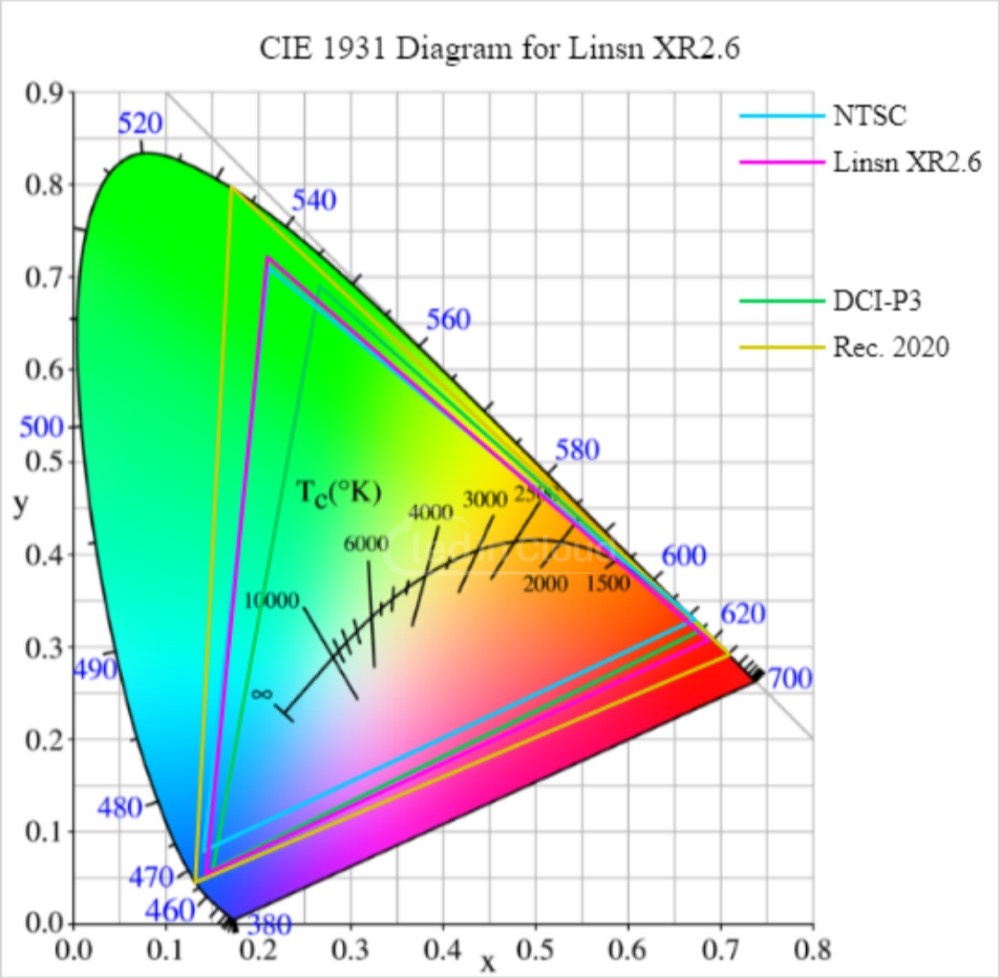
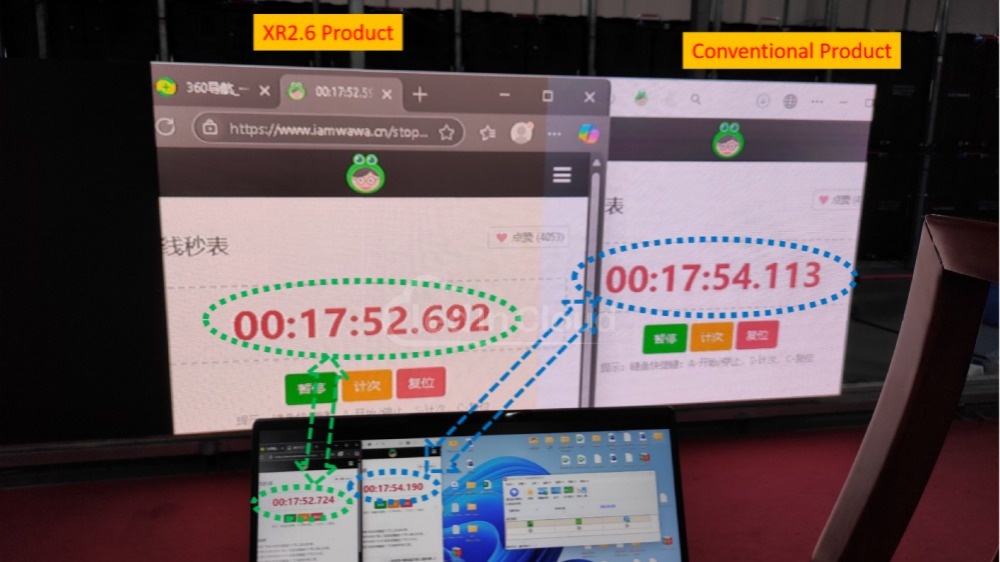
Latency
XR2.6: Achieves ultra-low latency of 32ms (≤2 frames). In XR stages, where the virtual background must move perfectly with the camera, this near-instant response keeps perspective aligned. Actors can move freely, and directors see results without delay.
Conventional: Around 77ms (~4.5 frames). The lag between camera and screen can cause noticeable mismatch—like when the background drags slightly behind camera motion—which breaks immersion and complicates post-production fixes.
HDR vs SDR
XR2.6: Fully supports HDR, showing brighter highlights, richer shadows, and a dynamic range close to what the human eye sees. A sunrise scene shows glowing skies without losing detail in the darker ground. HDR is also key for meeting Netflix, Disney+, and other platform standards.
Conventional: Limited to SDR, which compresses brightness and shadow detail. Scenes may look flat, and directors cannot achieve the same cinematic impact without heavy grading later.
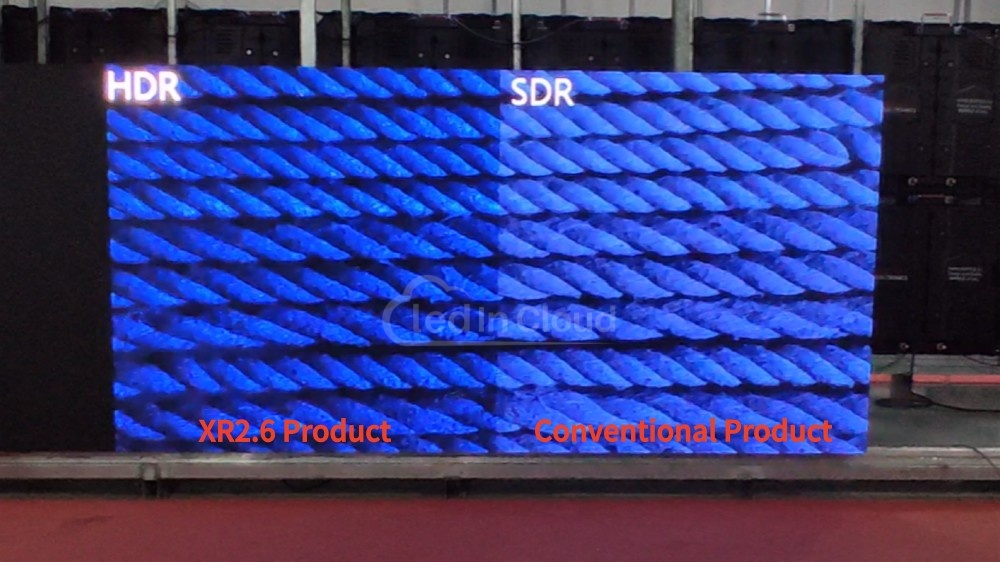
Active 3D & Variable Frame Rate
XR2.6: Supports Active Shutter 3D and flexible frame rates from 24fps to 240fps. This makes it ideal for high-action shots, VR/AR simulations, and gaming-related productions where motion has to stay smooth. Directors can also switch frame rates mid-production without reconfiguring the wall.
Conventional: Limited to fixed frame rates and lacks 3D capability. Fast movement may show motion blur or tearing, which is unacceptable for sports broadcasts or XR gaming content.
XR LED Wall and the Viewer Experience
XR LED is not only about saving time and cost for production teams. It also changes how the audience experiences the final content.
XR LED screen solves this by creating scenes directly in-camera:
- More realistic images
Lighting, reflections, and fine details appear naturally on set. The camera captures them as part of the real scene.
- Stronger immersion
Accurate depth and perspective make viewers feel like they are inside the environment, not watching a digital backdrop.
- Higher quality
By reducing compositing errors and “keying artifacts,” the final footage looks seamless and cinematic.
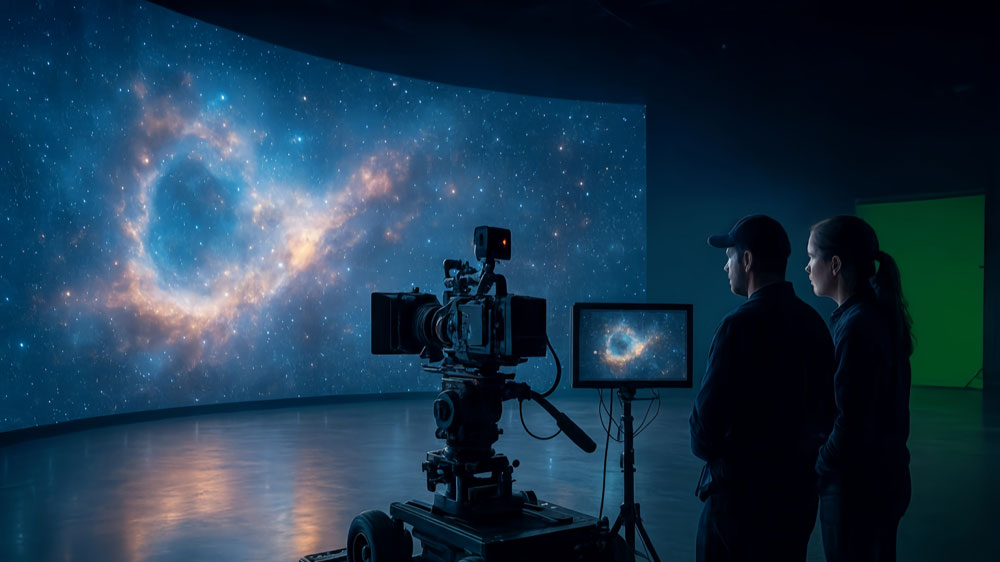
Common Questions About XR LED Walls
Below, we’ve compiled answers to the most common questions to help you understand everything about XR LED walls.
Q1. What is the difference between an XR LED wall and a normal LED screen?
A standard LED display is made for advertising or events. An XR LED wall is optimized for filming: high refresh rate, HDR, and tight pixel pitch to avoid flicker and distortion on camera.
Q2. Can XR LED screens replace green screens completely?
Not in every case. Green screens are still cheaper for simple shots. But for realistic lighting, reflections, and faster workflows, most studios now prefer LED wall virtual production.
Q3. What software is used with XR LED displays?
Most setups use Unreal Engine for real-time rendering. A media server connects the engine, the camera tracking system, and the LED wall to make the background move naturally with the camera.
Q4. Are XR LED panels only for film?
No. They are also used in live events, concerts, advertising, online streaming, and training simulations. The technology is spreading beyond film and TV.
Send Us Message
If you have any LED display projects or technical problems regarding our LED display products. Please send us a message, we will reply to you in 24 hours.
ATTENTION: lf you bought LED Display & LED Module from other suppliers, Please get help from them directly.
XR LED Screen Guide: Virtual Production LED Walls Explained
XR LED screen, often called virtual production LED walls, are now the backbone of many modern film and TV sets. Instead of shooting in front of a plain green backdrop, directors use massive LED displays to build digital worlds right on stage. Actors see the environment around them, cameras capture it in real time, and the final image looks natural without heavy post-production.
Table of Contents
1. What is an XR LED Screen?
An XR LED screen is a large, high-resolution LED wall designed for filming and live production. Some call it a virtual production LED wall. Whatever the name, the idea is the same: replace a green screen with an LED display that plays digital scenes in real time.
The screen itself is made of many LED panels joined together. From a distance, they look seamless, like one giant monitor. Behind the wall, a rendering engine such as Unreal Engine generates the background—a desert, a city street, even outer space. When the camera moves, the content shifts with it. This keeps the perspective and depth correct, so what the lens sees looks natural.
In practice, the term “XR LED screen” often refers to the whole stage setup, not only the wall. Many XR stages also include a ceiling made of LED panels, floor tiles, camera tracking systems, and powerful controllers to keep everything synchronized.
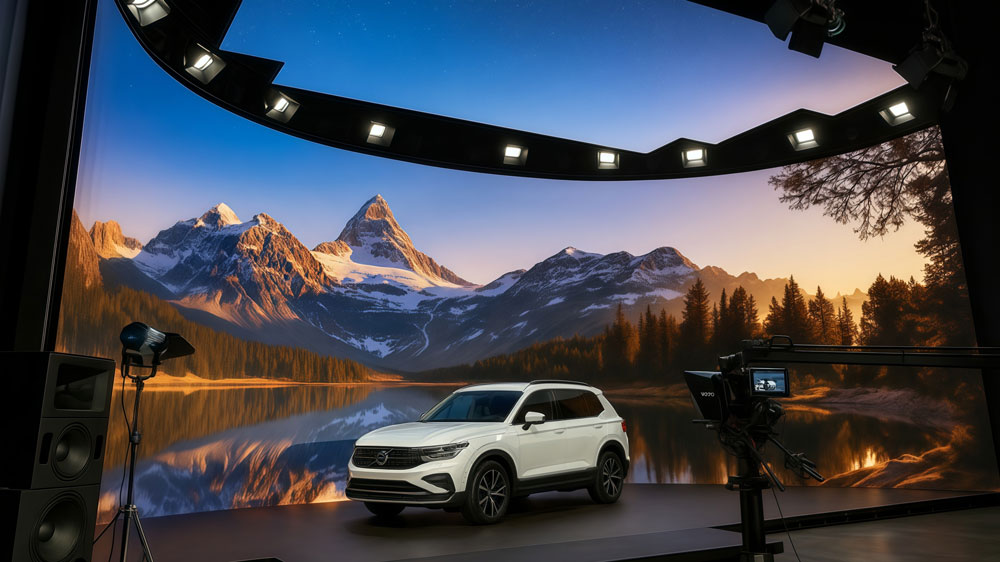
(1) XR in Simple Terms
Before looking at the screen itself, it helps to know what XR means. XR stands for Extended Reality, a broad term that includes VR, AR, and MR.
- VR (Virtual Reality): a fully digital world, usually experienced with a headset.
- AR (Augmented Reality): digital images layered on top of real life, like filters on a phone.
- MR (Mixed Reality): real and virtual objects blended together, interacting in real time.
- XR (Extended Reality): the umbrella that covers all of the above.
In film and TV, XR usually refers to using these digital tools inside a studio with LED walls.
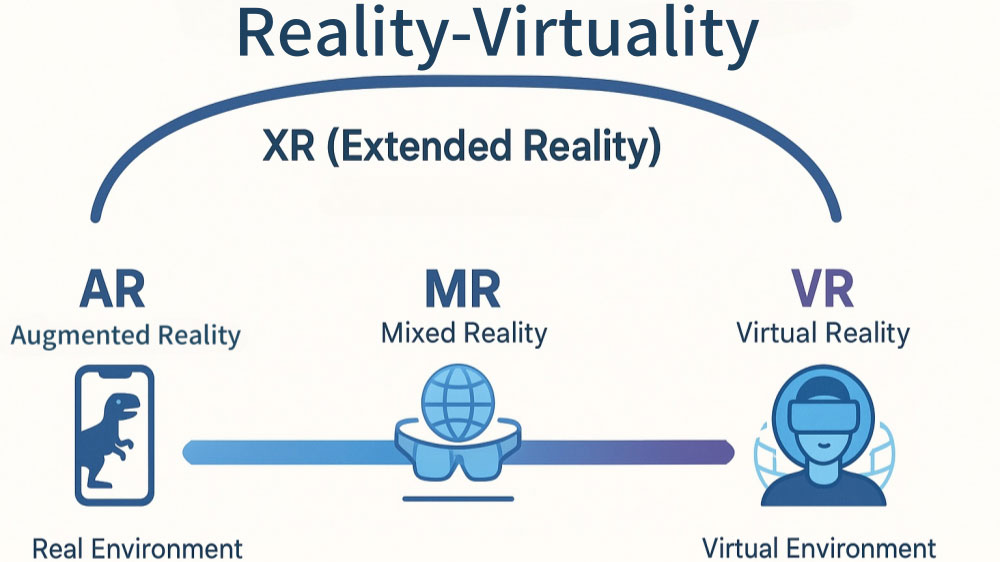
(2) How It Looks on Set
- The LED wall plays the background: a desert, a city, or even outer space.
- A real-time engine, often Unreal Engine, renders the content.
- Camera tracking makes sure the perspective changes correctly as the camera moves.
The result is a background that looks natural in-camera. No guesswork. No empty green backdrop.
(3) Different Names, Same Idea
You may see terms like XR LED screen, virtual production LED wall, or LED volume. Strictly speaking:
- Virtual production LED wall usually points to the wall itself.
- XR LED screen often refers to the larger system: wall, ceiling, floor, tracking, and servers.
In practice, people use both terms for the same purpose—building digital worlds on LED displays and filming them directly in camera.
2. How Does a XR LED Wall Work?
An XR LED wall looks like a giant backdrop made of LED panels, but what makes it special is how it interacts with the camera and the software behind it. The system brings digital environments onto the stage and keeps them consistent as the camera moves.
Here’s how it works in practice:
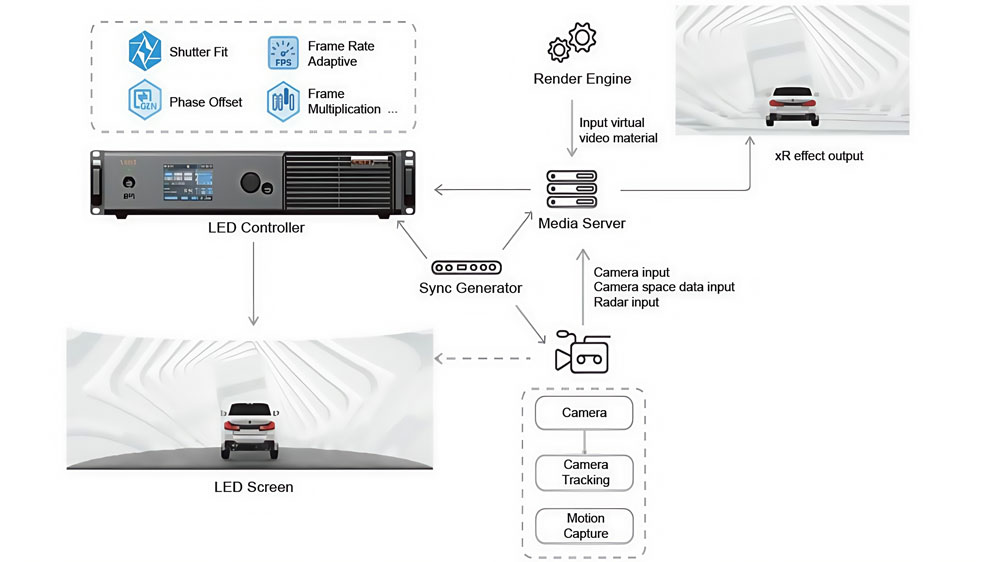
Step 1: The LED wall shows the scene
The wall is built from high-resolution LED panels joined seamlessly. A real-time graphics engine, such as Unreal Engine, feeds 3D environments into the display—deserts, cityscapes, star fields, or any setting the story needs. Unlike a regular screen, these panels are bright enough to act as part of the lighting setup and detailed enough to look natural even when the camera is close.
Step 2: The camera and wall stay in sync
Every camera on set is connected to a tracking system. As the lens pans, tilts, or moves forward, tracking data goes straight to the rendering engine. The engine instantly updates the image on the wall, so the background shifts in correct perspective. Mountains in the distance move as they would in real life, giving depth and parallax that match the camera’s viewpoint.
Step 3: Lighting and reflections come from the wall
Because the wall emits real light, the digital scene influences the physical set. A sunset on the wall throws warm light across the actors. Neon signs in a city scene reflect off car windows. This natural interaction saves time in post and makes the composite believable straight out of the camera.
Step 4: The system keeps everything locked together
A central control stack—media servers, NovaStar processor, and sync tools—ties the workflow together. It ensures that the wall, the camera, and any extra stage lighting respond in real time, without flicker or delay. Technologies like genlock and high refresh rates keep the image stable for professional cameras.
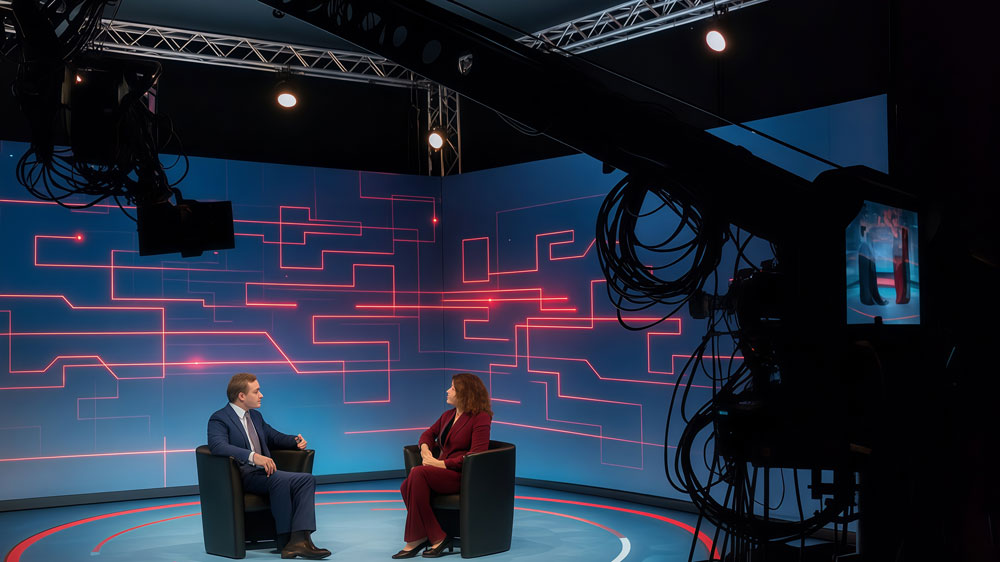
The result is straightforward: actors perform inside a digital world, the camera captures it as if it were real, and directors can review shots instantly.
3. Benefits of XR LED Screens
Using an XR LED screen changes how films, ads, and live shows are made. Compared with traditional green screen or location shoots, it offers clear advantages that save time and improve creative results.

Realistic lighting and reflections
The LED wall is not just a background—it is a source of light. A desert scene will cast harsh sunlight. A night cityscape will paint neon glows on metal and glass. These natural reflections are nearly impossible to fake in post-production.
Immediate results on set
Directors and cinematographers see the final image while filming. No guessing how it will look later. They can adjust the background, change the time of day, or shift camera angles instantly. This makes decision-making faster and more confident.
Better performance from actors
Standing in front of a living environment helps actors react naturally. They no longer have to imagine a monster or horizon against a green wall. Instead, they can interact with the virtual space, which leads to more convincing performances.
Faster production cycles
With XR LED walls, much of the work that used to happen in post now happens during the shoot. That cuts down editing time, reduces travel, and avoids building massive sets. Many productions report up to 50% shorter shooting schedules when switching from green screen to LED.
Easy scene changes
A single stage can hold endless environments. Switch from a mountain range to a futuristic city with a click. No need to relocate or rebuild. This flexibility allows crews to film multiple locations in one day, inside the same studio.
Consistent results
Weather, light, and location access often slow traditional shoots. In a studio with an XR LED screen, conditions are always control LED. Every shot can be repeated with the same look, which is vital for continuity.
4. XR LED Display vs. Green Screen
For years, green screens were the standard for creating digital environments. They still have their place, but the rise of XR LED displays for virtual production has changed expectations. The two methods may look similar at first glance, yet the workflow and results are very different.
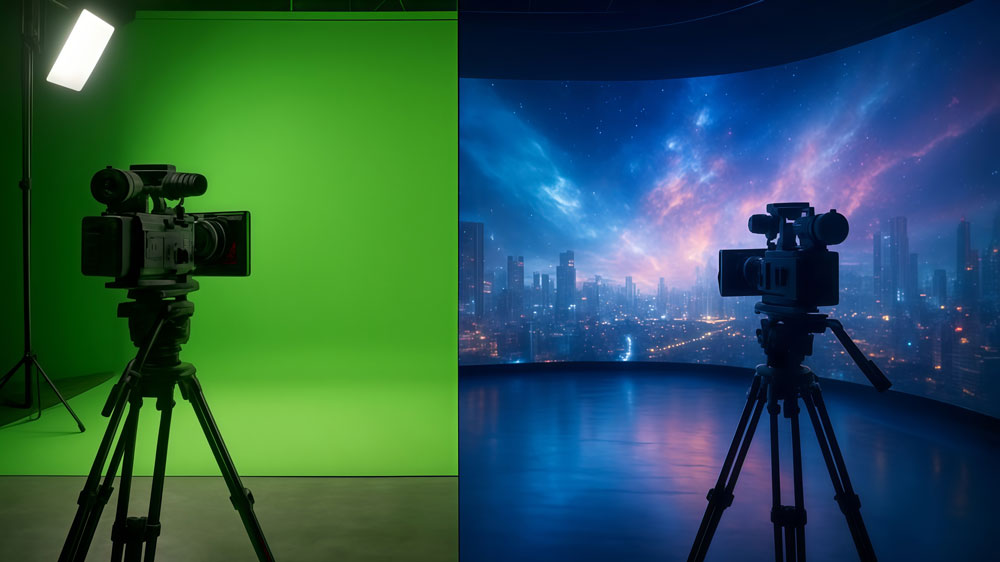
4.1 How they create the scene
Green screen: Actors perform in front of a solid-colored backdrop. The digital world is added later during post-production.
Virtual Production LED wall: The environment is displayed live on LED panels. What the camera records already includes the digital background.
4.2 Lighting and reflections
Green screen: Since the backdrop emits no light, the crew must add artificial lighting to mimic the scene. Reflections on shiny props need to be fixed in post.
Virtual Production LED wall: The wall lights the set naturally. If the scene is a sunset, warm tones fall across the actors instantly. This reduces the need for heavy editing.
4.3 Actor performance
Green screen: Actors often struggle to imagine the world around them, since they only see a blank screen.
Virtual Production LED wall: With a moving background on all sides, actors interact with their surroundings more naturally, leading to stronger performances.
4.4 Production speed
Green screen: A large share of the work shifts to post-production, which can take months.
Virtual production LED wall: Most of the compositing is captured in-camera. Crews can film multiple locations in a single day without leaving the studio.
4.5 Costs and long-term value
Green screen: Lower upfront cost, but extended post-production hours often make it expensive over time.
Virtual Production LED wall: Higher setup investment, but reduced editing, travel, and set-building expenses can make it more cost-effective for frequent shoots.
In short, green screens rely on fixing everything after the shoot. An XR LED display lets you capture finished shots on the spot. For filmmakers, advertisers, and broadcasters, this shift is not just about better visuals—it’s about a faster, more efficient way of working.
5. Applications
An XR LED wall is no longer limited to Hollywood sets. It is now used in many fields where flexible, high-quality visuals are needed.
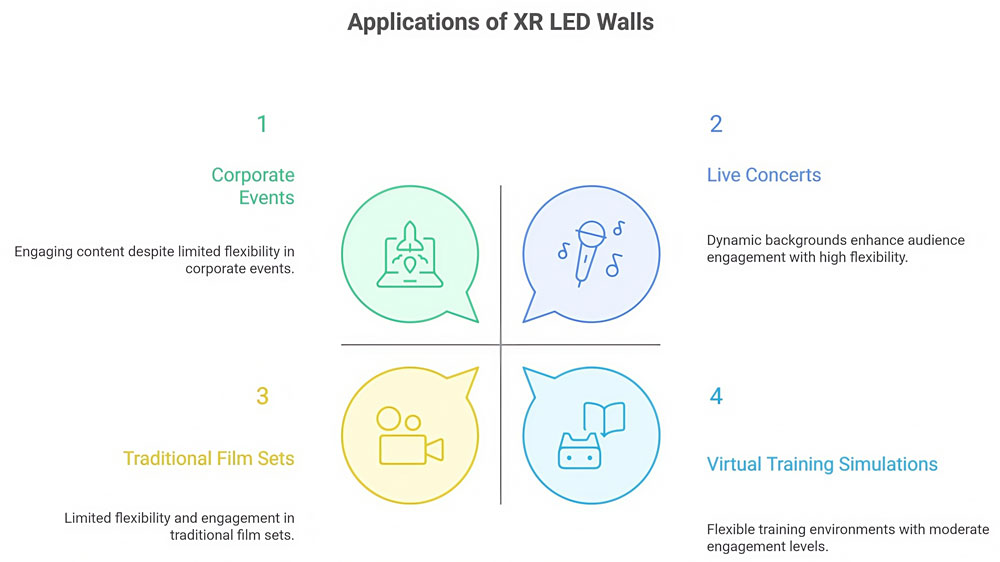
Film and TV production
The most common use is in movies and series. A full LED wall film production setup lets crews build entire worlds inside a studio, from deserts to outer space.
Advertising and commercial shoots
Brands use LED screens for virtual production to film products in different locations without moving crews around the world. One studio can deliver multiple backdrops in a single day.
Broadcast and live shows
A virtual studio LED wall creates dynamic backgrounds for news, talk shows, and concerts. Unlike traditional sets, the look can change instantly to match each program.
Corporate and events
Many companies use LED wall filming for product launches, virtual conferences, or live streaming. The wall makes the content more engaging than flat green screen shots.
Training and simulation
Some industries deploy LED panels for virtual production to build training environments, from flight simulations to emergency response drills.
6. Choosing the Best XR LED Display
Not every LED panel can handle the demands of XR and virtual production. When building a stage or a virtual studio LED wall, there are several factors to check before investing.
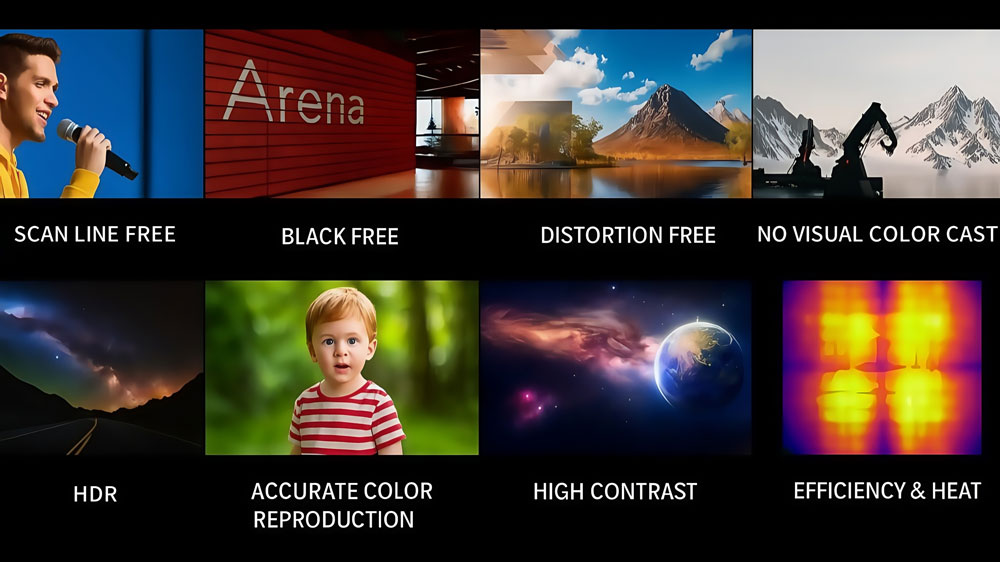
(1) Refresh rate and scan performance
A top XR LED display should run at a very high refresh rate to avoid scan lines when filmed. Panels below 3,840Hz often show rolling bands on camera. Premium models reach 7,680Hz or higher for perfectly clean images.
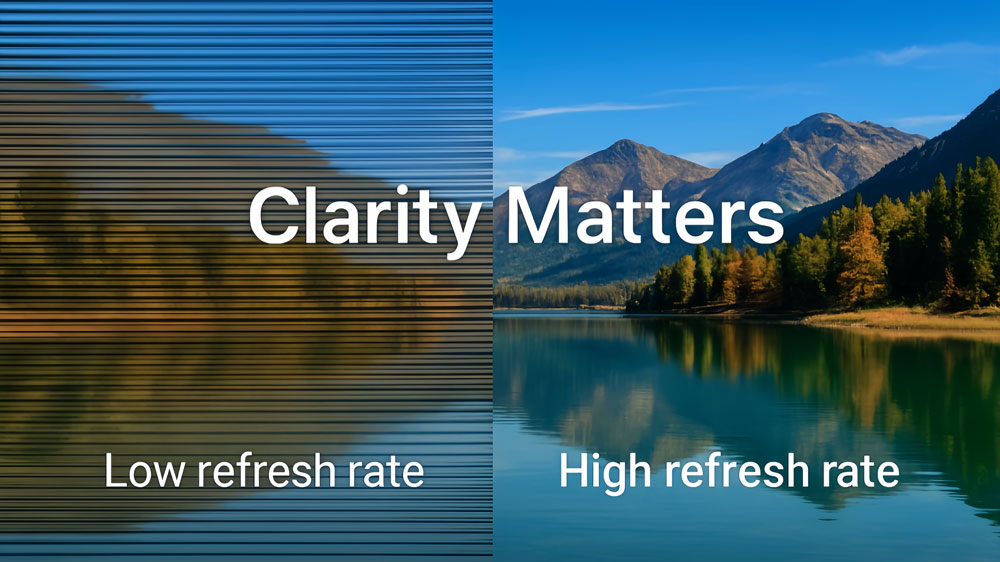
(2) Viewing angle stability
Cameras move across wide angles on set. A reliable virtual production LED wall should not shift color or distort at the edges. Wide-angle performance keeps the illusion intact.
(3) Color accuracy and HDR support
For film work, colors must be consistent and true to life. Look for panels that offer HDR and 16-bit processing. This gives natural gradients and precise skin tones, essential for a LED wall for virtual production.
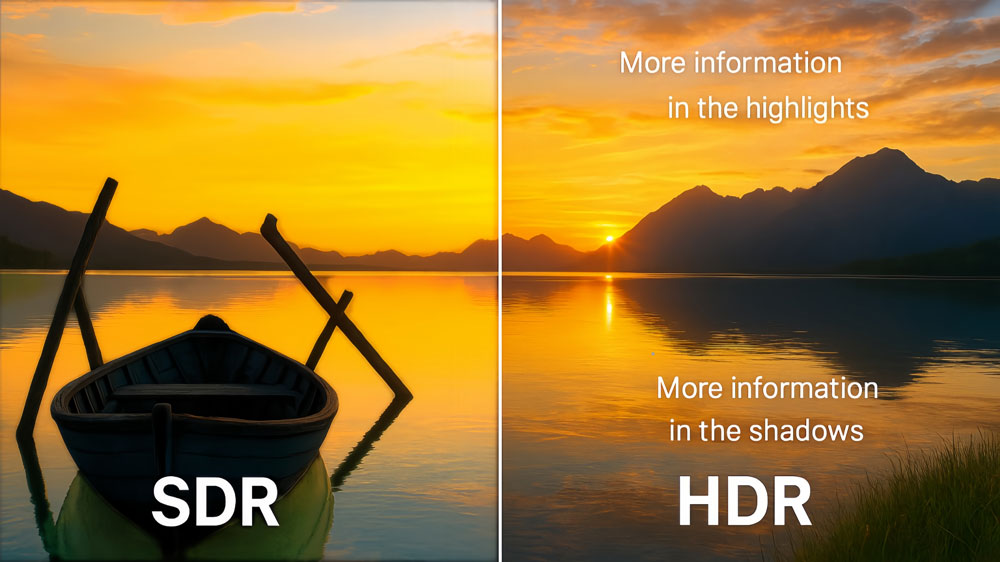
(4) Build quality and maintenance
Film studios need sturdy cabinets that are light enough to move but strong enough to stay aligned. Front and rear service options make maintenance faster, especially in large LED volumes.
(5) Contrast and black levels
Scenes with deep shadows need panels with high contrast. A poor black level breaks immersion. The best panels deliver rich blacks without sacrificing brightness.
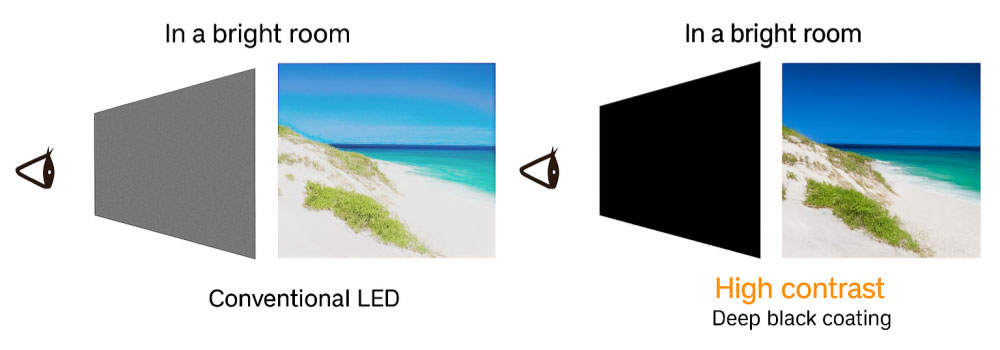
(6) Power and thermal management
Large XR stages run for hours. A good system has stable brightness without overheating. Lower power draw also reduces running costs over time.
(7) System integration
An LED wall does not work alone. It must sync with camera tracking, media servers, and engines like Unreal. Always confirm that the display is certified or tested for full XR workflows.
7. XR LED Wall Price
The cost of an XR LED wall depends on several factors: panel quality, screen size, processing system, and studio requirements. Unlike standard rental screens, an LED wall for virtual production must meet higher demands such as flicker-free shooting, HDR support, and accurate color reproduction. These requirements make the price range wider.
Key cost drivers include:
- Pixel pitch (tighter pixel pitch raises cost but improves camera performance)
- Refresh rate and scan design (needed to avoid scan lines)
- HDR and grayscale processing (for cinematic quality)
- Power and cooling design (affects stability in long shoots)
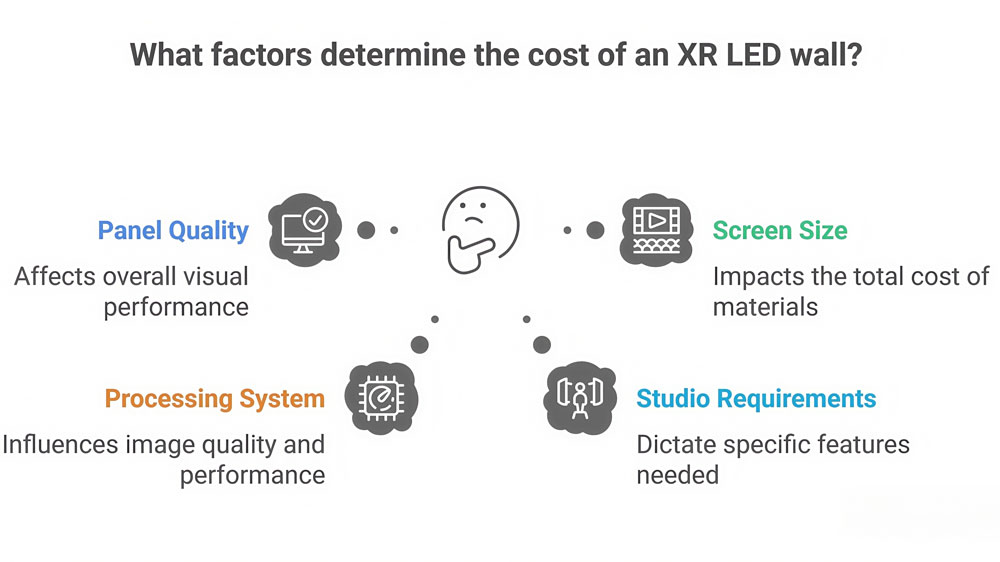
Because of these variables, it is hard to give one fixed XR LED wall price. Many studios now compare options online before deciding.
Register LedInCloud platform, you can:
- View and compare virtual production LED wall price ranges across different specs
- Check the LED wall virtual production cost estimates for both purchase and rental
- Explore updated products like the XR Stage Series
- Access free downloads and technical guides
8. LedInCloud XR Stage Series
The LedInCloud XR Stage Series is designed for studios that want reliable performance during demanding shoots. Built with updated specs, it meets the technical requirements of XR while keeping installation and operation simple.
XR Stage Series
- High refresh rate and grayscale
- HDR display
- Color precision
- Wide viewing angles
- Lightweight cabinet
- Front and rear service
You can also log in to our LED Screen Cloud Platform to see prices, compare controllers, and access resources.
9. Future Trends
The future of XR LED walls is not just about better screens. It’s about how they will reshape production workflows and who will use them.
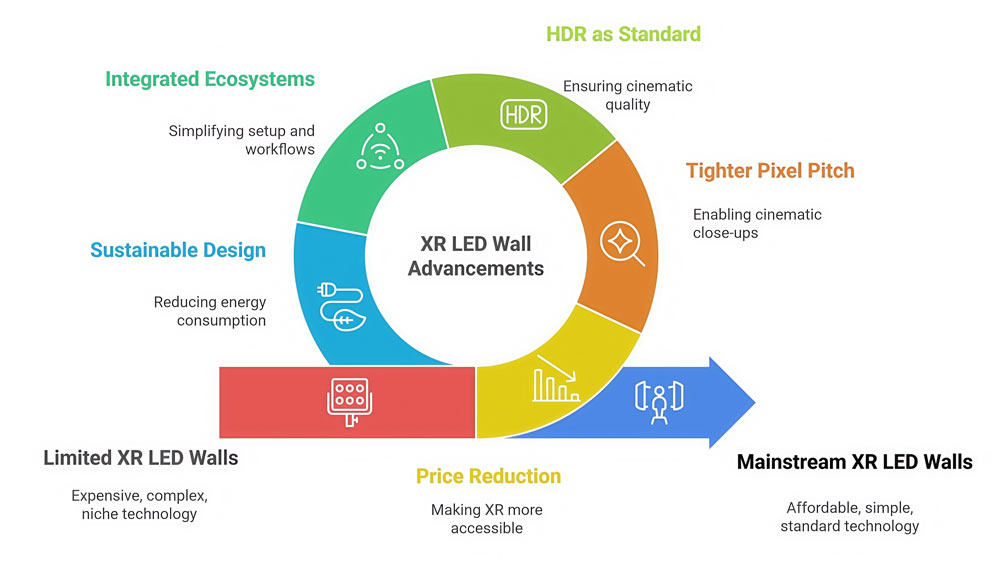
From high-end to mainstream: Until now, virtual production LED walls were used mainly by blockbuster studios. Prices are dropping, and smaller teams—commercial houses, live streamers, even schools—are starting to adopt them. The market is moving from a niche tool to a standard production method.
Tighter pixel pitch for cinematic detail: Most XR stages today use P2.6–P3.9 panels. Over the next few years, sub-P2 pixel pitch will become common. This will allow extreme close-ups without moire and make the background indistinguishable from real locations.
HDR as the new baseline: Streaming platforms now expect HDR delivery. Future XR LED displays will be built with HDR and wide color gamut by default. This means no more “optional upgrade”—cinematic quality will be standard.
Integrated virtual production ecosystems: Today, a lot of time goes into syncing the LED wall, camera tracking, and rendering. The trend is toward unified systems: media servers, control software, and LED screens for virtual production working as one package. This will cut setup time and make virtual shoots more plug-and-play.
Sustainable and power-efficient design: Large LED volumes consume massive energy. Next-gen panels will focus on efficiency: lower heat, smarter power supplies, and eco-friendly components. This will reduce not just costs but also the carbon footprint of big productions.
Beyond film studios: The same technology is starting to appear at concerts, exhibitions, product launches, and virtual classrooms. Expect LED screen virtual production to expand into entertainment, corporate communication, and even education as portable XR stages become easier to deploy.
10. Conclusion
An XR LED screen is more than a backdrop. It has become a key tool for filmmakers, advertisers, and broadcasters to build immersive worlds without leaving the studio. Compared to green screens, XR offers better lighting, more natural reflections, and a faster production cycle.
If you are planning to invest in an XR stage, the updated LedInCloud XR Stage Series is built to meet professional demands. For any questions, you can always contact LedInCloud directly. It’s the easiest way to plan your next virtual production project with clarity and confidence.
More Solutions
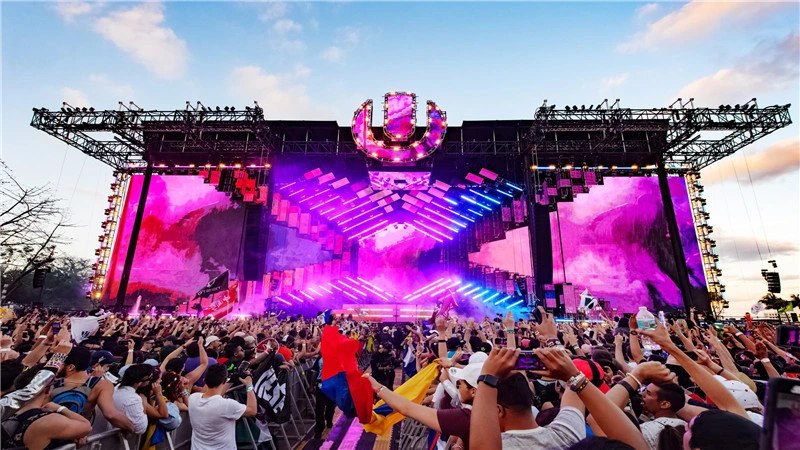
Event LED Screen
Delivering sharp visuals, smooth playback, and quick installation, making every gathering more engaging and memorable.
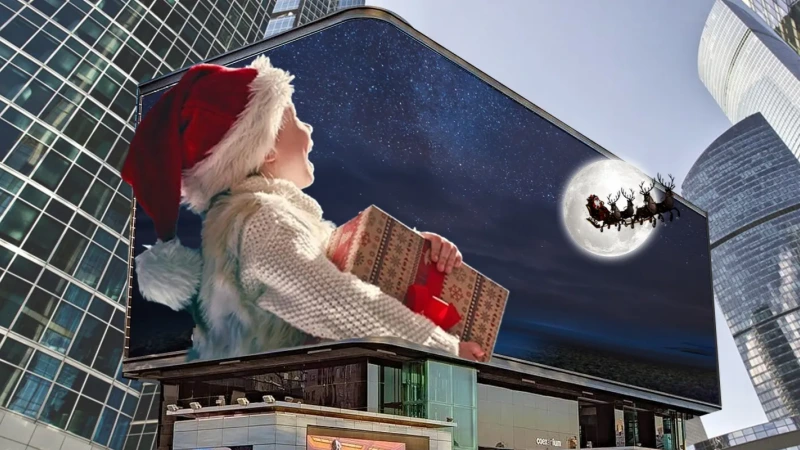
3D LED Screen
Eye-catching naked-eye 3D visuals that attract crowds and boost brand exposure in outdoor spaces.

Stage LED Screen
Dynamic visuals for concerts, events, and live shows, offering vivid effects and seamless synchronization.

Sports Stadium LED Screen
It shows live games, replays, scores, ads, and messages, helping fans see the action clearly from any seat.

